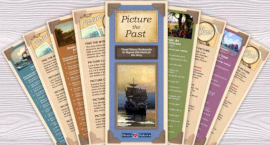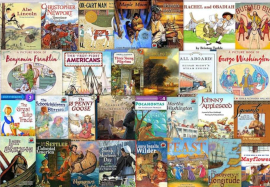You can use children’s picture books to teach early American history for the primary grades with Heart of Dakota’s Visual History set of children’s picture books and “bookmarks.” The publisher includes the set as an option with their complete program presented in Beyond Little Hearts for His Glory for ages six to eight, but it also works as a standalone.
Children learn about key people and events through both pictures and stories in the 29 books in the set. A few examples are Leif Eriksson by Shannon Knudsen, Christopher Newport, Jamestown Explorer by Sharon K. Solomon, The Discovery of Longitude by Joan Galat, The Very First Americans by Cara Ashrose, If You Were a Kid on the Mayflower by John Son, Martha Washington by Candice Ransom, and Abe Lincoln: The Boy Who Loved Books by Kay Winters. The stories are drawn from the periods of exploration, the colonization of America (with several stories related to the Pilgrims), and the American Revolution, with a few from later years about westward expansion, Abe Lincoln, Johnny Appleseed, Buffalo Bill, Laura Ingalls Wilder, and the steam engine.
There are a few ways you might use the Visual History set of books. Heart of Dakota uses three Christian Liberty Press books as spines, then expands history coverage with the Visual History books, and you might do something similar. If you’re not using Beyond Little Hearts for His Glory, you can add one or more spine books of your choosing that provide more comprehensive coverage of history, but it isn’t necessary to add spine books at this level. Young children begin to learn about particular people and events through the picture books, and they gradually put the pieces together to understand the bigger picture. If, on the other hand, you prefer to put more attention on spine books, you can spread learning over more than a year, adding in the Visual History books at pertinent points.
Picture the Past Bookmarks
 The Visual History set of books includes the set of Picture the Past bookmarks—29 large (3.5” x 8.5”) bookmarks, one for each book. The full-color bookmarks have discussion, comprehension, and narration questions on one side and a "Picture Clues" activity on the reverse. The activities on the bookmarks help homeschoolers ensure that children are learning from the picture books.
The Visual History set of books includes the set of Picture the Past bookmarks—29 large (3.5” x 8.5”) bookmarks, one for each book. The full-color bookmarks have discussion, comprehension, and narration questions on one side and a "Picture Clues" activity on the reverse. The activities on the bookmarks help homeschoolers ensure that children are learning from the picture books.
The questions include some “Who did what?” type questions, but they also take students into deeper levels of critical thinking by asking questions such as these for the book, Leif Eriksson: “How did the story of Bjarni’s discoveries inspire Leif?” and “Name some reasons why the land the men explored seemed good to Leif.” A few questions serve as narration prompts, such as “Use the pictures to retell what the family made for market over the winter. What did they do in March, April, and May?“ (Question 12 for Ox-Cart Man by Donald Hall).
The Picture Clues activity on the reverse of each card should be especially fun. For each book, children are given four clues, and they are to identify the picture in the book that matches the clues. The four clues are identified as having to do with setting, action, character, or mood. For example, for Martha Washington, two of the clues are:
Picture Clue 3 – Mood: Pay attention to how each picture makes you feel. The “Mystery Picture” looks joyful and welcoming, with fresh spring colors. George and Martha look content.
Picture Clue 4 – Setting: Examine the setting of each picture. The “Mystery Picture” is set outdoors, with blooming trees and Mount Vernon’s white walls and red roof in the background.
You can see how the questions and Picture Clues help students develop literary analysis and critical thinking skills while reinforcing knowledge of historical events.
If you prefer to borrow the 29 books from the library, you can purchase the Picture the Past Bookmark set on its own.
Summary
The Visual History set of books and Picture the Past Bookmarks work very well together as an age-appropriate way to teach early American history to children in grades one through three.








